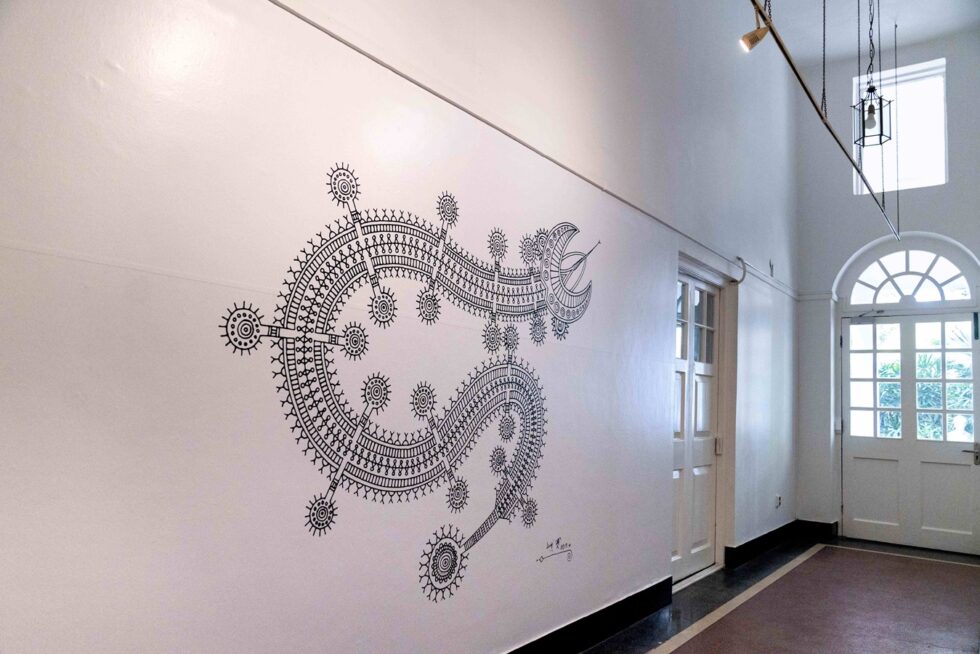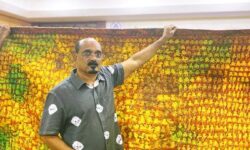
NEW DELHI:
An entrancing journey through a thick mangrove forest in India, a close look at pink aerial roots of a maize variety found in Mexico that oozes a mucous-like gel to fix nitrogen from the atmosphere, a dive into the deep sea to capture the fascinating shapes of single-celled diatoms that are so crucial to Earth.
Welcome to ‘Critical Zones. In Search of a Common Ground’, a unique art exhibition that highlights the crucial connectedness between each life form on Earth, brought to Delhiites by the ZKM |Karlsruhe (Germany), and the Goethe-Institut / Max Mueller Bhavan Mumbai.
‘Critical Zones’ is an extensive collaboration between international artists, designers, scientists, and activists. The New Delhi edition, inaugurated on 3 February, is on until 9 March at Goethe-Institut / Max Mueller Bhavan New Delhi, from 10:00 am to 7:00 pm.
The exhibition, which has already been featured in Mumbai, Pune and Kolkata, as well as Colombo in Sri Lanka, uses mixed media artwork very tellingly to highlight the symbiotic relationship between all life forms, and at the same time nudge public consciousness on the need to preserve our Earth by adopting new actions.
Speaking on ‘Critical Zones’, Director, Programmes South Asia, Goethe-Institut / Max Mueller Bhavan New Delhi, Katharina Görig, said: “It is a key priority for the Goethe-Institut to initiate and promote artistic formats and cultural projects that address ecological, social, and economic sustainability. We consider Critical Zones not only an exhibition, but also an innovative platform to bring together artists, scientists, and civil society, to co-create holistic interventions that expand momentum for current narratives on sustainability.”
Bettina Korintenberg, who has curated the show, said the beauty of the exhibition is that it is itself a kind of ever-evolving ecosystem. Every space it travels to, and it touches, it transforms and gets transformed by the space itself.
“Responding to the location in New Delhi, the exhibition is built up in layers. We start on the thin surface outside to observe, to recalibrate our senses, to get sensitive. And then we transit inside the Critical Zone and encounter a plurality of scales, rhythms, spatiality and temporalities made up by human and non-human assemblages which bring into awareness common threads and other possibilities to live together,” pointed out Bettina, who is also Head of ifa Galleries.
Mira Hirtz, the co-curator of the exhibition and Project Coordinator, ZKM | Karlsruhe, said, “It has been nearly two years since the ZKM, in collaboration with the Goethe-Instituts in South Asia, embarked on a travelling tour with this exhibition. It has seen an incredible response, and I am very happy to culminate it with two last iterations, one of them here in New Delhi. The context, landscapes and lively cultural scene of India’s capital enrich the exhibition with new questions, creative responses, and deep conversations on how to co-exist and find a common ground with all forms of life.”
As part of its section titled Activation Programme, Max Mueller Bhavan New Delhi has partnered with environmental and social organisations like Toxics Link, Edible Routes, Swechha India and Crow Immersive Theatre, intending to investigate and analyse the issues of environmental importance in and around New Delhi.
On Thursday, 8 February, an ‘Exhibition Walkthrough and Interaction with Featured Artists’, with the participation of two young artists Ankur Yadav and Anuja Dasgupta from New Delhi.
On Friday, 9 February, there will be a talk on ‘Politics, Nature and Knowledge’ by historian and filmmaker Jahnavi Phalkey, moderated by artist and founding director of Toxics Link, Ravi Agarwal.
On Saturdays, 10 and 17 February, a Plastics Recycling Tour has been planned. The tour will consist of site visits to e-waste separation and disposal centres in Seelampur, and view process of plastic waste moulding at Inderlok. This tour is led by Toxics Link. During their day-long sojourn to Seelampur, known as India’s largest e-waste processing area and dumping ground, the artists and activists will spend some time with the plastic waste collectors and see the conditions in which they live and recycle waste.
On Sunday, 11 February, a Workshop on Art and Ecology titled ‘Drawing Relations’, has been organised. It is being led by Sculptor and Founding Director of SARA Center, Arunkumar H.G and artist Gagan Singh.
The artists whose works are on display at the New Delhi edition include: Rohini Devasher, Sonia Mehra Chawla, Uriel Orlow, Stephane Verlet-Bottero, Ravi Agarwal, Parag Tandel, Kadambari KT, Edith Morales, Lynn Margulis and Sonia Levy, among others.
The exhibition is a travelling adaptation of ‘Critical Zones. Observatories for Earthly Politics.’, which was conceived and exhibited at ZKM | Center for Art and Media Karlsruhe (2020–2022), based on a concept by Bruno Latour, a French philosopher, and Peter Weibel, an Austrian artist, curator and new media theoretician.
The term ‘Critical Zone’ describes the fragile layer of the Earth, its surface, which is only a few kilometres thin and on which life is created. In addition to emphasizing the vulnerability of this thin layer, the term also sheds light on the numerous controversies that have triggered new political attitudes towards it.
For its New Delhi edition, Goethe-Institut / Max Mueller Bhavan New Delhi also showcases the works of six young artists who were selected based on their responses to a series of questions centred around ecology and sustainability.




